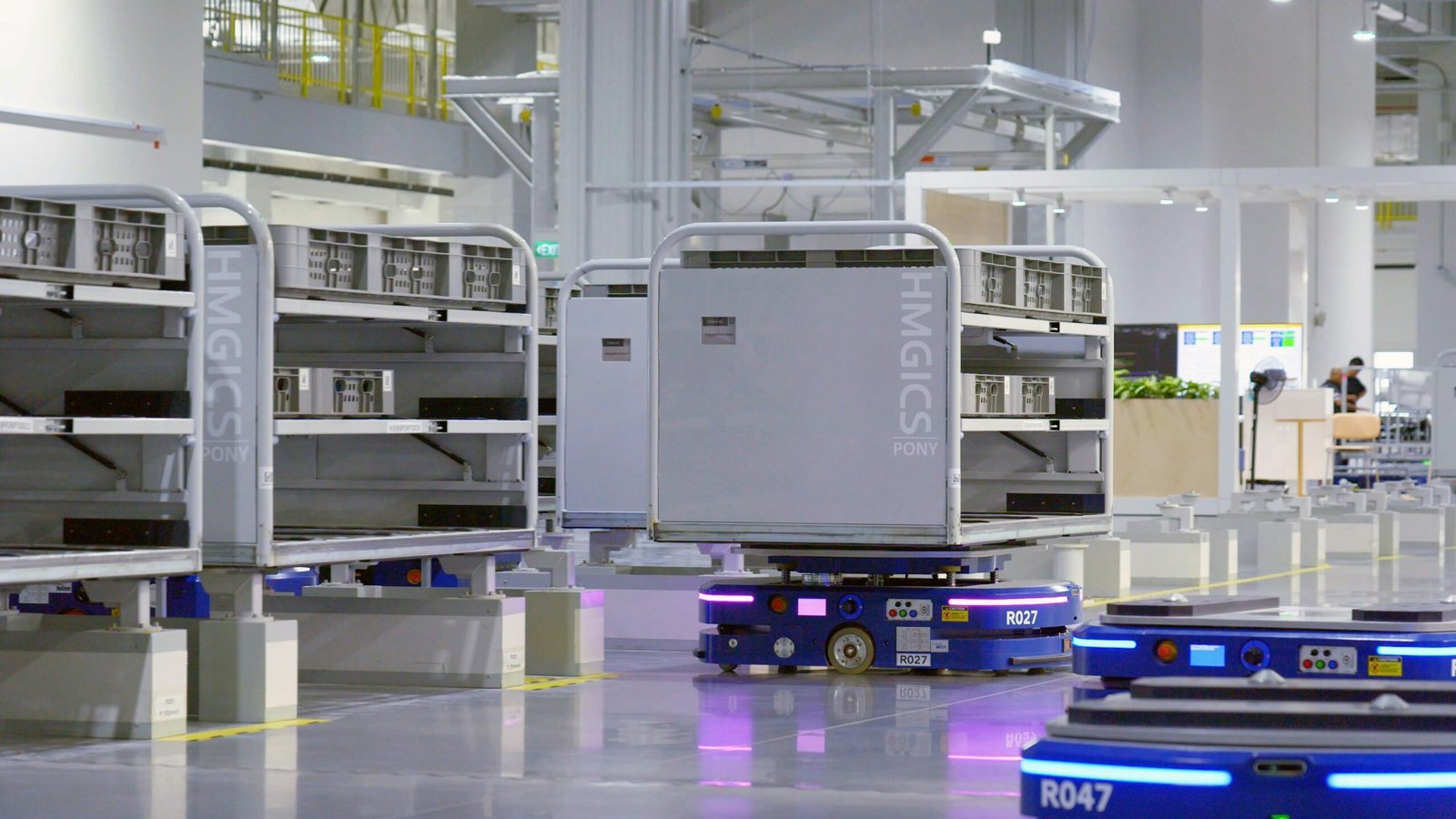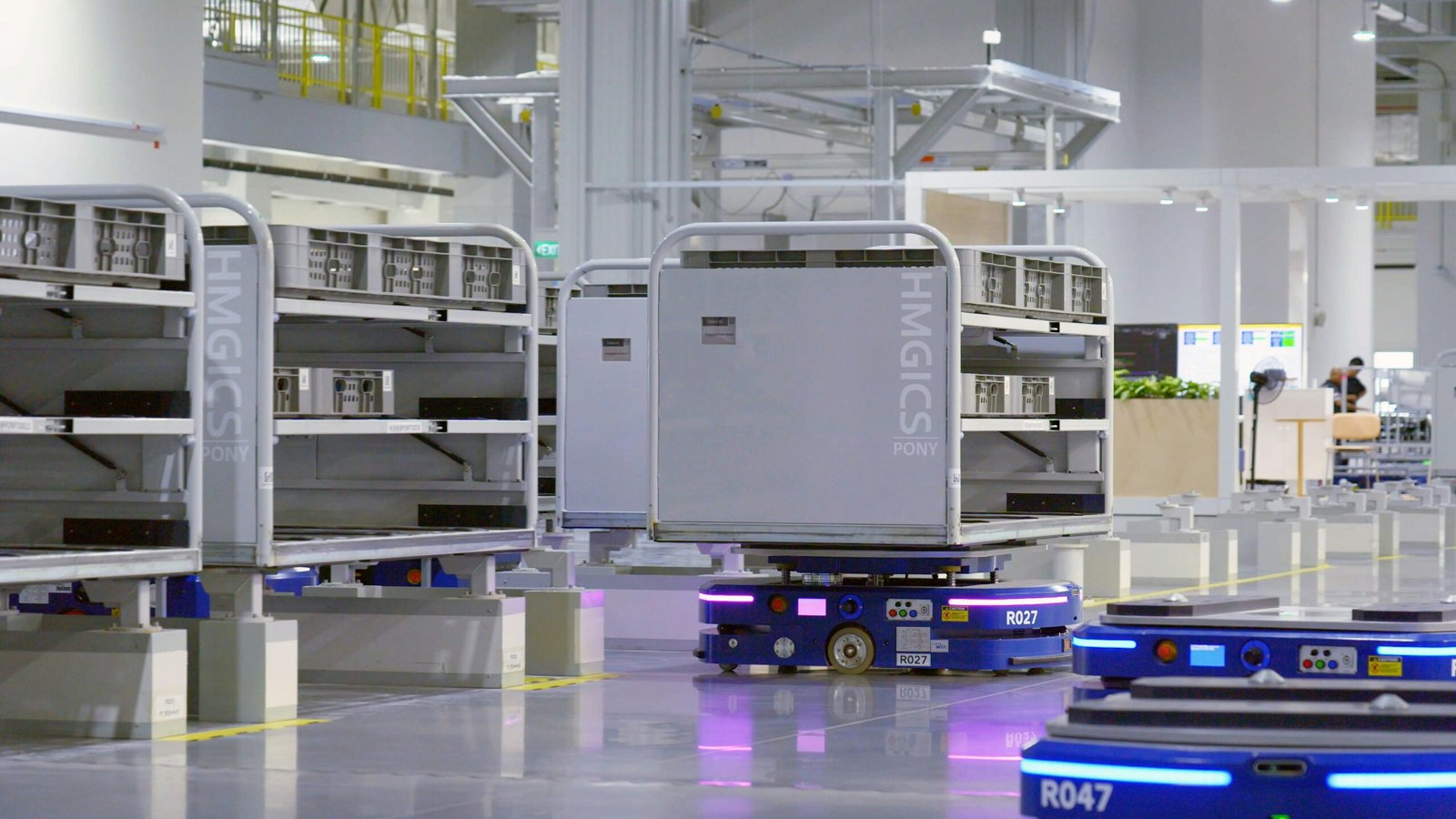
Introduction to AI-Guided Autonomous Factories
AI-guided autonomous factories represent a transformative shift in the manufacturing landscape, leveraging cutting-edge technologies to enhance productivity, efficiency, and adaptability. At the core of these factories are advanced artificial intelligence algorithms that enable machines and systems to operate independently while coordinating seamlessly with one another. The integration of AI in manufacturing processes not only optimizes workflows but also enables real-time decision-making backed by data analytics.
Central to the concept of smart manufacturing is the idea of autonomy. In an AI-guided autonomous factory, machines can perform tasks with minimal human intervention, which significantly reduces operational downtime and eliminates the risks associated with human error. This level of automation allows businesses to respond swiftly to market demands and changing consumer preferences, creating a more resilient manufacturing ecosystem capable of thriving in an increasingly competitive environment.
The technological innovations that facilitate AI-guided autonomous factories include the Internet of Things (IoT), machine learning, and robotics. IoT sensors enable machines to communicate with each other and gather vital performance data. Machine learning algorithms analyze this data to detect patterns, predict equipment failures, and optimize production schedules, resulting in improved resource allocation. Furthermore, robotic systems enhance precision and speed, performing tasks ranging from assembly to quality control.
The significance of these autonomous factories cannot be overstated. They embody a shift towards sustainable manufacturing practices, minimizing waste through optimized production processes. Enhancements in efficiency and productivity can lead to substantial cost savings, making it easier for companies to invest in innovation and growth. As industries evolve, understanding the role of AI-guided autonomous factories becomes paramount for professionals and organizations aiming to remain competitive in the market.
Key Technologies Behind AI-Guided Factories
AI-guided autonomous factories leverage several critical technologies that significantly enhance the efficiency and productivity of smart manufacturing processes. One of the cornerstone technologies is machine learning, which enables systems to analyze vast amounts of data and learn from it in real-time. For instance, predictive maintenance powered by machine learning algorithms can forecast equipment failures before they occur, allowing manufacturers to address potential issues proactively, thus minimizing downtime and enhancing operational efficiency.
Robotics plays an equally crucial role in the operation of AI-guided factories. Advanced robotics, equipped with artificial intelligence capabilities, can perform complex tasks previously done by human workers. For example, robotic arms can manage intricate assembly processes, improving speed and precision while reducing the likelihood of errors. This integration of robotics not only streamlines operations but also allows for better allocation of human labor towards more strategic roles, further driving the efficiency of smart manufacturing.
The Internet of Things (IoT) serves as a vital backbone for these autonomous environments. IoT devices embedded in machinery facilitate real-time communication and data exchange among various components on the production floor. This interconnectedness allows for better monitoring of equipment performance and inventory levels. Furthermore, IoT technology enables manufacturers to gather insights that lead to data-driven decision-making, further enhancing productivity in manufacturing operations.
Lastly, big data analytics is indispensable in the realm of AI-guided factories. By processing and analyzing large datasets generated from multiple sources, manufacturers gain comprehensive insights into operational patterns and trends. For instance, the implementation of big data analytics can optimize supply chain management by predicting demands and aligning production schedules accordingly. Thus, it is evident that each of these technologies — machine learning, robotics, IoT, and big data analytics — plays a significant role in shaping the future of manufacturing through AI-guided autonomous factories.
Benefits of AI-Guided Autonomous Factories
The integration of AI-guided autonomous factories into the manufacturing landscape brings forth a multitude of benefits that significantly enhance operational processes. One of the most compelling advantages is increased efficiency. By leveraging advanced algorithms and machine learning capabilities, these smart manufacturing systems optimize production schedules and workflows, thereby minimizing downtime. This can lead to a substantial increase in output without a corresponding rise in labor costs, allowing businesses to meet consumer demand with agility.
Moreover, the financial implications of adopting AI-guided factories are noteworthy. By automating repetitive tasks and utilizing predictive maintenance, operational costs can be significantly reduced. According to industry research, companies implementing AI technologies have reported reductions in labor and maintenance costs by up to 30%. This financial leverage can provide businesses with a competitive edge in a rapidly evolving market.
Quality control is another domain where AI-driven systems excel. With the ability to monitor production processes in real-time, these factories can identify defects and anomalies far earlier than traditional manufacturing practices allow. As a result, the consistency and quality of products improve, leading to fewer returns and enhanced customer satisfaction. A notable example includes a major automotive manufacturer that adopted AI-guided quality assessment, reducing defect rates by 40% within a year.
Furthermore, the safety of workers is considerably enhanced in AI-guided autonomous factories. The incorporation of autonomous machinery reduces the likelihood of accidents by taking on risky tasks and operating in hazardous environments. Technology applications that utilize AI for risk assessment further promote a safer working atmosphere, ensuring compliance with safety regulations and fostering a culture of well-being.
In essence, the benefits of AI-guided autonomous factories are multifaceted, encompassing improved efficiency, cost reductions, enhanced product quality, and increased safety, positioning these smart manufacturing solutions as pivotal for the future of the manufacturing sector.
Challenges and Limitations
The integration of AI-guided autonomous factories into smart manufacturing processes is a transformative shift in the industrial landscape. However, this transition is not without its challenges and limitations, which can impede the widespread adoption of such technologies.
One significant hurdle is the high initial investment required for establishing these autonomous systems. Implementing AI and advanced robotics entails substantial financial outlay for equipment, software, and infrastructure upgrades. Many manufacturers, especially small and medium-sized enterprises, may find this cost prohibitive. The return on investment, while potentially substantial in the long term due to increased efficiency, often discourages immediate investment due to the uncertainty surrounding future performance.
Furthermore, there is a pressing need for a skilled workforce capable of operating and maintaining these AI-guided systems. The rapid evolution of technology necessitates continuous learning and adaptation, which can lead to skill gaps in the current workforce. Training programs are essential, yet developing skilled professionals in areas such as machine learning, data analysis, and robotics takes time and resources that industries may not readily have.
Data security is another critical concern in the advanced manufacturing space. With the reliance on interconnected systems and vast amounts of data being processed, vulnerabilities can expose manufacturers to cyberattacks. Ensuring robust security measures and protocols is paramount to protecting sensitive information and maintaining operational integrity.
Lastly, ethical considerations regarding workforce displacement cannot be overlooked. The introduction of AI in manufacturing raises questions about job availability and the potential for widening economic disparities. Addressing these concerns requires not only technological innovation but also thoughtful policies aimed at facilitating workforce transition while promoting inclusivity.
Each of these challenges requires careful consideration and strategic planning to mitigate obstacles as the industry strives towards the vision of AI-guided autonomous factories. The future of manufacturing depends on overcoming these limitations to fully realize the potential of smart manufacturing.
Real-World Applications of Autonomous Factories
The implementation of AI-guided autonomous factories is transforming manufacturing across various sectors. A pioneering example can be found in the automotive industry, where companies like Tesla have embraced smart manufacturing techniques. Tesla’s Gigafactory employs advanced robotics and AI algorithms to optimize assembly line operations, resulting in higher production efficiency and reduced operational costs. The integration of machine learning allows for predictive maintenance, minimizing downtime and enhancing productivity, thereby setting a benchmark for modern manufacturing practices.
Another notable case is Siemens’ Amberg Electronics Plant in Germany, which epitomizes the capabilities of autonomous factories. By utilizing an extensive network of IoT devices and AI systems, the facility has achieved remarkable levels of automation. Approximately 75% of the manufacturing processes are autonomously managed, facilitating real-time data analysis and rapid response to production anomalies. This approach not only streamlines operations but also significantly improves product quality, showcasing the potential of AI-guided systems in enhancing operational reliability.
The food and beverage industry is also reaping the benefits of smart manufacturing innovations. An instance of this is the Coca-Cola Company, which incorporates AI technologies to optimize their bottling operations. By leveraging machine learning algorithms, Coca-Cola can accurately forecast demand, adjust production schedules, and minimize waste. As a result, the company has enhanced its supply chain efficiency while also reducing its environmental impact.
Furthermore, companies like Foxconn are exploring AI-powered robotic processes within their manufacturing plants, particularly in electronics assembly. These initiatives not only improve speed and precision but also address labor shortages by reducing reliance on manual labor. These examples indicate that the move towards AI-guided autonomous factories is not merely a trend; it is a fundamental shift that can drive substantial change across multiple industries, ultimately redefining the manufacturing landscape.
The Role of AI in Supply Chain Management
The integration of artificial intelligence (AI) into supply chain management signifies a transformative shift within the landscape of smart manufacturing and autonomous factories. As industries increasingly rely on data-driven approaches, AI is positioned to enhance various supply chain functions, including demand forecasting, inventory management, and logistics optimization.
One significant advantage of AI in demand forecasting is its ability to analyze vast amounts of historical data to predict future customer demand with higher accuracy. Traditional forecasting methods often fall short due to their reliance on static models. In contrast, AI-driven algorithms can incorporate a range of variables—such as market trends, seasonal fluctuations, and consumer behavior—enabling organizations to make more informed decisions. This capability is crucial for ai-guided autonomous factories that need to align production schedules effectively with anticipated market needs, thus reducing waste and enhancing operational efficiency.
Moreover, AI significantly impacts inventory management by optimizing stock levels and enhancing visibility across the supply chain. Through machine learning models, manufacturers can automate inventory tracking and reorder processes, minimizing the risks of stockouts or overstock situations. Smart manufacturing systems employ real-time data to adjust inventory thresholds dynamically, ensuring that resources are allocated efficiently. This proactive approach not only streamlines operations within autonomous factories but also contributes to cost savings.
Additionally, logistics optimization is a critical area where AI technology excels. By analyzing traffic patterns, delivery schedules, and route efficiencies, AI systems can suggest optimal shipping routes and modes of transportation. This results in reduced transit times and lower costs, enhancing overall supply chain agility. Autonomous factories leverage these insights to create more responsive logistics frameworks, allowing businesses to adapt swiftly to changing market conditions.
In conclusion, AI’s influence on supply chain management marks a significant advancement in smart manufacturing and the operation of ai-guided autonomous factories. By facilitating more accurate demand forecasting, efficient inventory management, and optimized logistics, AI is enhancing the resilience and responsiveness of the manufacturing ecosystem.
Future Trends in Autonomous Manufacturing
The landscape of manufacturing is evolving rapidly, particularly with the advent of AI-guided autonomous factories. As we look ahead, several trends are anticipated to shape this evolution, driven by advancements in artificial intelligence technology and its application in smart manufacturing. One of the most significant trends is the enhancement of machine learning algorithms, which are becoming increasingly sophisticated. These improvements will enable AI systems to process vast amounts of data in real-time, leading to more efficient production processes and better decision-making capabilities.
Alongside technological advancements, the integration of sustainable practices into smart manufacturing will gain greater importance. Industries are beginning to recognize the need for environmentally responsible production methods. This shift is expected to lead to AI-guided autonomous factories prioritizing energy efficiency and waste reduction. By harnessing data analytics, factories can optimize resource usage, reduce their carbon footprint, and enhance their overall sustainability performance. As such initiatives become commonplace, the manufacturing sector may witness a transition toward a circular economy, where products and materials are reused and recycled within the production cycle.
Furthermore, the evolution of collaborative robots, or cobots, will play a pivotal role in autonomous manufacturing. These robots are designed to work alongside human operators, facilitating tasks that require precision and consistency while allowing workers to focus on more complex responsibilities. The partnership between human ingenuity and AI technology will mark a new era of production, amplifying productivity and minimizing error rates.
In conclusion, the future of AI-guided autonomous factories is poised for transformative changes driven by advancements in AI technology, sustainability initiatives, and the rise of collaborative robotics. By embracing these trends, the manufacturing industry can look forward to increased efficiency, reduced environmental impact, and enhanced production capabilities, aligning closely with the overall goals of modern smart manufacturing.
The Workforce of the Future
The emergence of AI-guided autonomous factories is revolutionizing the manufacturing sector, resulting in profound changes in the workforce landscape. As smart manufacturing technologies become increasingly integrated into daily operations, the demand for new skill sets will necessitate significant adjustments in employee training and professional development. Workers will need to familiarize themselves with advanced technologies, including robotics, data analytics, and machine learning, which are fundamental to maximizing the potential of these autonomous systems.
To adapt to this evolving environment, companies will be required to invest in comprehensive retraining and upskilling programs. Such initiatives aim to equip employees with the necessary expertise to work alongside AI and robotic systems. Traditional manufacturing roles are transforming, and workers will need to focus on developing competencies in areas such as programming, systems analysis, and critical thinking. This emphasis on continuous learning and adaptability is crucial as workers engage with increasingly sophisticated tools and platforms in their daily tasks.
Moreover, the notion of coexistence between human workers and advanced technologies will be a pivotal theme in future manufacturing environments. While there may be concerns regarding automation leading to job displacement, the reality is likely to present a more nuanced scenario. AI-guided autonomous factories can enhance human productivity, allowing employees to focus on higher-level tasks, creative problem-solving, and innovation. Therefore, the role of the workforce will be not only to operate these technologies but also to interpret data, provide insights, and drive decision-making. Ultimately, the successful integration of smart manufacturing into the industrial landscape depends on creating a collaborative coexistence between humans and machines, paving the way for a skilled workforce that is well-prepared to meet the challenges and opportunities of a rapidly changing future.
Conclusion: Embracing the Future of Manufacturing
The landscape of manufacturing is undergoing a transformative shift, driven largely by the advent of AI-guided autonomous factories. These systems represent a significant leap towards smart manufacturing, where production processes are enhanced by data-driven insights and automation. The integration of artificial intelligence in production not only streamlines operations but also promotes efficiency and precision, factors crucial for maintaining competitiveness in a global market.
As discussed, the transition towards autonomous factories signifies more than just technological advancement; it highlights the necessity for manufacturers to adapt to an evolving ecosystem. Embracing these intelligent systems offers numerous advantages, including reduced operational costs, improved product quality, and the ability to swiftly respond to market demands. Nonetheless, the shift toward smart manufacturing is not solely reliant on technology. It requires collaboration between advanced AI solutions and the skilled human workforce that operates alongside these innovations.
Incorporating AI into the manufacturing sector necessitates a shift in mindset, where human talent is viewed as an integral component of technological integration. There must be a recognition that while machines can enhance efficiency, the creativity, problem-solving skills, and adaptability of human workers remain invaluable. This synergy is vital to unlocking the full potential of AI-guided autonomous factories, ensuring that manufacturers can thrive amid rapid technological advancements.
Ultimately, the path to a successful future in manufacturing lies in the harmonious collaboration between human expertise and artificial intelligence. By embracing this new paradigm, manufacturers can navigate the challenges of the modern landscape, leveraging the capabilities of smart manufacturing to achieve their goals and secure their position in the industry. The journey toward AI-guided autonomous factories is not merely about adopting new technologies but fostering an environment where innovation and human insight can flourish together.
- Name: Mohit Anand
- Phone Number: +91-9835131568(Sumit Singh)
- Email ID: teamemancipation@gmail.com
- Our Platforms:
- Digilearn Cloud
- EEPL Test
- Live Emancipation
- Follow Us on Social Media:
- Instagram – EEPL Classroom
- Facebook – EEPL Classroom
- Go back to google
Internal links
- Building Your First Python Project: A Step-by-Step Guide
- Python vs. Other Languages: Why It’s the Best Choice for Beginners
- Artificial Intelligence in the Future: Trends, Challenges & Opportunities
- Transforming Healthcare with AI: Faster Diagnosis and Better Treatment
- The Future of AI in Business: Smarter, Faster, Better
- The Truth About AI Ethics: Challenges, Risks, and Real Solutions
- The Future of AI and Data Science: Smarter, Faster, Better
- ML vs. DL: Exploring Their Unique Roles in AI




